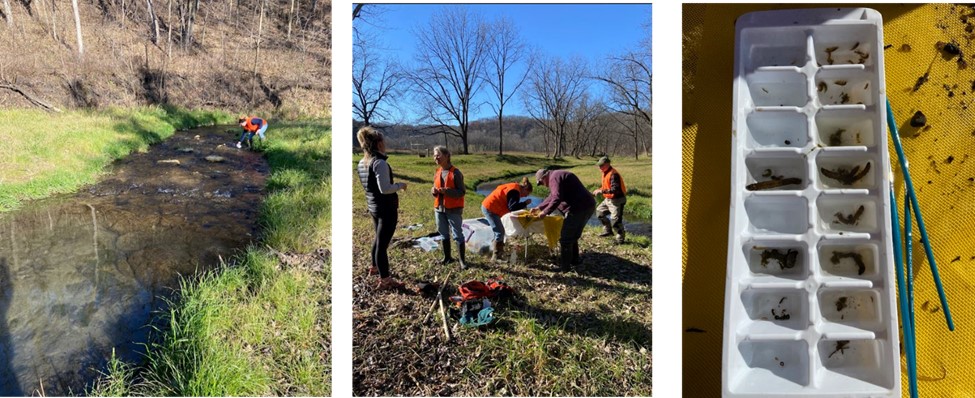How do Macroinvertebrates Fare Following Stream Improvement Projects?
By Dr. Jennifer Biederman
The sight of an in-stream habitat improvement project in progress can be a bit eye-opening – heavy machinery, including large excavators are working along the banks and in the stream, often moving large amounts of soil to slope the banks while digging out silted in pools and re-constructing new riffle habitat to support food production and spawning habitat. An outside observer might wonder, is the disturbance of construction doing more harm than good?
The answer is yes! Trout tolerate the temporary disturbance of construction very well – they quickly move to unimpacted areas of the stream and return when the conditions return to normal. What about macroinvertebrates, though?
Stream ecosystems are adapted for periodic disturbances
Naturally, stream ecosystems are adapted to periodic flooding – including more severe flooding events that can seemingly scour all the “life” from an impacted reach. These events would even be catastrophic – if not for the incredible ways that stream-dwelling organisms have evolved to survive these episodes that can temporarily decimate populations.
Typically, in-stream habitat improvement projects are located within relatively small reaches (half mile to a mile in length) in 2, 3, or 4th order streams that often have miles of unimpacted habitat upstream. A construction project, like a flood, is a temporary disturbance. So how do macroinvertebrates survive such disturbances?
Naturally, many aquatic macroinvertebrate populations exist for most of their lives as benthic larvae, living in and among the stream bottom. Some of these larvae, including mayflies and scuds, “drift” downstream, either during higher flows following rainfall or from simply becoming dislodged from a rock, so emigration and immigration over the course of a stream is pretty normal. Other aquatic macroinvertebrates, like midges, can impressively find the deep interstitial spaces in streams, which are small gaps and voids between particles like gravel, cobbles, sand, and other substrates within and below the streambed. These microhabitats can provide refuge during disturbances including flooding and construction.
Adult aquatic macroinvertebrates, including midges, mayflies, caddisflies, and stoneflies, have evolved reproductive strategies that promote dispersal and colonization, helping them quickly re-establish populations in streams after disturbances like flooding.
- Midges (Chironomidae): These tiny insects are prolific breeders. Female midges lay hundreds of eggs on the water’s surface, which quickly hatch into larvae that settle into streambed sediments. Adult midges are strong fliers, allowing them to move upstream and downstream or disperse to neighboring streams, ensuring the widespread distribution of eggs and larvae.
- Mayflies (Ephemeroptera): Mayflies are known for their synchronized emergence, where thousands of adults emerge simultaneously, often creating large swarms. Females lay their eggs directly on the water surface or dip into the water to deposit them, ensuring that the eggs are spread over a wide area. The swarming behavior and short-lived nature of adults maximize the chances of mating and dispersal before egg-laying, allowing them to recolonize streams quickly.
- Caddisflies (Trichoptera): Caddisflies have strong flying abilities, and adults can travel considerable distances between streams to find suitable habitats for laying eggs. Females deposit eggs directly into the water, sometimes attaching them to submerged vegetation or rocks, ensuring the eggs are well-positioned for development. Some species lay eggs in a gelatinous mass that adheres to substrates, protecting them and allowing dispersal in flowing water.
- Stoneflies (Plecoptera): Adult stoneflies also have strong flight capabilities, although they often stay close to the stream. Females can carry their eggs in large clumps, and after mating, they drop these egg masses onto the water surface. The eggs then sink and attach to substrates. This method allows stoneflies to distribute their eggs widely along stream sections, aiding in recolonization efforts across various habitats.
These dispersal and reproductive strategies—ranging from drifting, high egg production, synchronized swarming, to strategic egg-laying—enable these macroinvertebrates to effectively disperse and colonize streams, ensuring their populations remain resilient even after significant disturbances.
Recent macroinvertebrate observations post-construction at Cedar Valley Creek and Trout Brook
Cedar Valley Creek (Winona County)
Whenever possible, it’s important to document the ecological uplift that stream habitat projects provide for stream ecosystems – trout and macroinvertebrates alike. A local group of Save Our Streams citizen science volunteers visited Cedar Valley Creek in November 2023, three months following the completion of a 1-mile habitat improvement project by MNTU. The group used a kick net to sample aquatic macroinvertebrates at the most downstream riffle constructed during the project. They were excited to report that, even a short time after project completion, the sample contained some of the highest abundances and best diversity relative to other streams that the group had sampled previously that year. The group documented different mayfly and caddis fly taxa, midges, scuds, snails, and cranefly larvae.

Trout Brook (Dakota County)
MNTU completed a ¾ mile long stream habitat improvement project in September of 2023, adjacent to an upstream ¾ miles habitat project completed in 2017. During regular inspection visits this summer, turning over rocks and digging through the substrate has revealed that recolonization has been impressive here, as well.
Below is a video from September 2024, where MNTU habitat director, Jennifer Biederman, and executive director, John Lenczewski, turn over rocks to see what kinds of macros had found a home in the new riffle habitat.
This weekend, during the Fall 2024 MNTU Habitat Tour, we visited Trout Brook and showed some attendees what kind of bugs were to be found. Many different mayflies, caddisflies, midges, scuds, and snails were thriving in the newly restored habitat!

